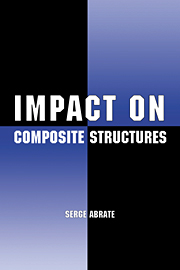5 - Damage Prediction
Published online by Cambridge University Press: 19 October 2009
Summary
Introduction
Impact damage usually follows some very complex distributions, and it may not be possible to reconstruct the entire sequence of events leading to a given damaged state. For low-velocity impacts, damage starts with the creation of a matrix crack. In some cases the target is flexible and the crack is created by tensile flexural stresses in the bottom ply of the laminate. This crack, which is usually perpendicular to the plane of the laminate, is called a tensile crack. For thick laminates, cracks appear near the top of the laminate and are created by the contact stresses. These cracks, called shear cracks, are inclined relative to the normal to the midplane. Matrix cracks induce delaminations at interfaces between adjacent plies and initiate a pattern of damage evolution either from the bottom up or from the top down. Therefore, while it is possible to predict the onset of damage, a detailed prediction of the final damage state cannot realistically be achieved.
Two types of approaches are used for predicting impact damage. The first type attempts to estimate the overall size of the damaged area based on the stress distribution around the impact point without considering individual failure modes. The general idea is that impact induces high stresses near the impact point and that these localized stresses initiate cracks, propagate delaminations, and eventually lead to the final damage state. Section 5.2 describes how this approach is used for predicting damage size for thick laminates, which behave essentially as semi-infinite bodies. In Section 5.3, the approach is applied to thin laminates, which are modeled as shear deformable plates.
Information
- Type
- Chapter
- Information
- Impact on Composite Structures , pp. 161 - 171Publisher: Cambridge University PressPrint publication year: 1998
